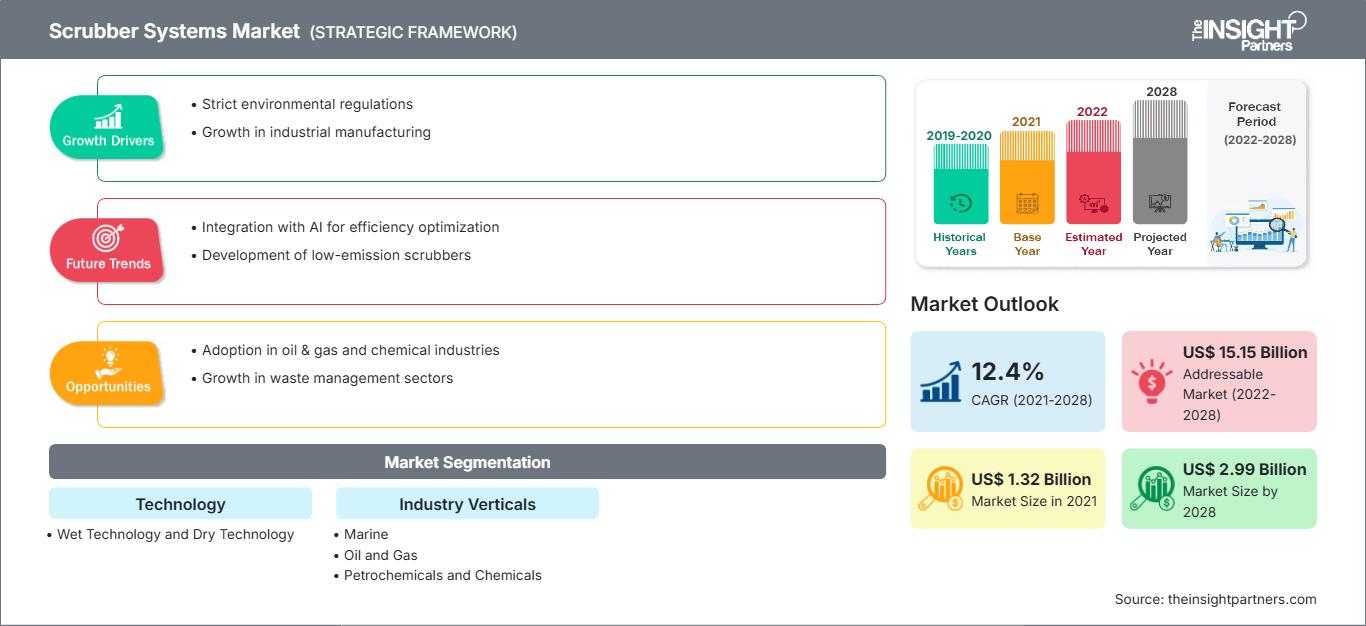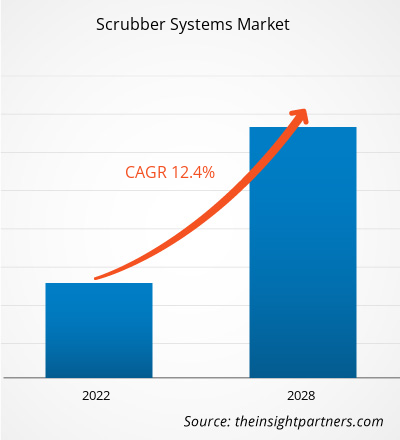El mercado de sistemas de depuración se valoró en 1.316,0 millones de dólares estadounidenses en 2021 y se prevé que alcance los 2.989,2 millones de dólares estadounidenses en 2028; se espera que crezca a una tasa de crecimiento anual compuesta (TCAC) del 12,4% entre 2021 y 2028.
Las principales industrias manufactureras, como la del cemento, el vidrio, la química y petroquímica, la alimentaria y agrícola, y la farmacéutica, son conocidas por sus emisiones de gases contaminantes. Por consiguiente, las estrictas regulaciones ambientales impuestas a estas industrias impulsan el mercado. Por ejemplo, la industria del cemento es una de las más contaminantes, ya que libera partículas de dióxido de nitrógeno (NO₂) y dióxido de azufre (SO₂) durante su producción. Además, el aumento del comercio internacional por vía marítima y el incremento de las actividades de ocio impulsan el crecimiento del mercado de sistemas de depuración de gases de escape. El auge del transporte marítimo mundial se debe a sus bajos costos y a la creciente demanda global de bienes y productos derivados del petróleo. Asimismo, la mayor participación en actividades de ocio, como cruceros y viajes internacionales, fomenta el uso de buques y, por consiguiente, impulsa el crecimiento del mercado de sistemas de depuración de gases de escape.
Impacto de la pandemia de COVID-19 en el mercado de sistemas de depuración
El brote repentino de COVID-19 ha tenido un impacto negativo significativo en la demanda de sistemas de depuración de gases de escape, en el contexto de la pandemia global. En agosto de 2020, Yara Marine Technologies, uno de los principales fabricantes de depuradores marinos, desvió su atención del mercado debido a la COVID-19 y a los bajos precios del petróleo. El gerente de innovación de la compañía declaró que tenían grandes expectativas para los sistemas de depuración en 2020, pero la COVID-19 lo cambió todo. Sin embargo, el mercado ha experimentado un aumento en la demanda desde el tercer trimestre, ya que varios gobiernos han implementado regulaciones estrictas para mantener la calidad del aire. Los sistemas de depuración de aire desempeñan un papel fundamental en la eliminación de partículas peligrosas de los gases de escape, lo que ha contribuido a la recuperación del mercado.
Obtendrá personalización gratuita de cualquier informe, incluyendo partes de este informe, análisis a nivel de país y paquetes de datos de Excel. Además, podrá aprovechar excelentes ofertas y descuentos para empresas emergentes y universidades.
Mercado de sistemas de depuración: Perspectivas estratégicas

- Obtenga las principales tendencias clave del mercado que se describen en este informe.Esta muestra GRATUITA incluirá análisis de datos, que abarcarán desde tendencias de mercado hasta estimaciones y pronósticos.
Perspectivas del mercado –
Mercado de sistemas de depuración
Aumento del comercio marítimo mundial y de las actividades de ocio
El auge del comercio internacional por vía marítima y el incremento de las actividades de ocio impulsan el crecimiento del mercado de sistemas de depuración de gases de escape. El aumento del comercio marítimo mundial se debe a sus bajos costes de transporte y a la creciente demanda global de bienes y productos derivados del petróleo. Además, la mayor participación en actividades de ocio como cruceros y viajes internacionales incrementa el uso de buques y, por consiguiente, impulsa el crecimiento del mercado de sistemas de depuración de gases de escape. Este aumento de las actividades de ocio se atribuye al incremento de la renta per cápita de los consumidores. Por lo tanto, el aumento de las emisiones de azufre de los buques —debido al floreciente comercio mundial— y la intensificación del transporte marítimo en las economías desarrolladas y en desarrollo están impulsando la instalación de sistemas de depuración de gases de escape.
Perspectivas basadas en la tecnología
Según la tecnología, el mercado de sistemas de depuración se divide en tecnología húmeda y tecnología seca. El segmento de tecnología húmeda ostentó una mayor cuota de mercado en 2021.
Los actores que operan en el mercado de sistemas de depuración se centran principalmente en el desarrollo de productos avanzados y eficientes.
- En julio de 2021, Babcock & Wilcox Environmental anunció que apoyaría la solicitud del Centro de Recursos Amager para construir una instalación avanzada de captura de dióxido de carbono en la planta de conversión de residuos en energía Amager-Bakke (Copenhill) del ARC en Copenhague, Dinamarca, por más de 140 millones de dólares estadounidenses.
- En septiembre de 2021, DuPont Clean Technologies presentó una solución innovadora y avanzada para la supresión de la pluma de vapor en sus depuradores MECS DynaWave para unidades de recuperación de azufre (SRU). Sennuba proporciona un control fiable de la corrosión y la supresión de la pluma en el sistema de depuración, minimizando el riesgo de obstrucción.
Perspectivas regionales del mercado de sistemas de depuración
Los analistas de The Insight Partners han explicado en detalle las tendencias regionales y los factores que influyen en el mercado de sistemas de depuración durante el período de previsión. Esta sección también analiza los segmentos y la geografía del mercado de sistemas de depuración en Norteamérica, Europa, Asia Pacífico, Oriente Medio y África, y Sudamérica y Centroamérica.
Alcance del informe de mercado de sistemas de depuración
| Atributo del informe | Detalles |
|---|---|
| Tamaño del mercado en 2021 | 1.320 millones de dólares estadounidenses |
| Tamaño del mercado para 2028 | 2.990 millones de dólares estadounidenses |
| Tasa de crecimiento anual compuesto global (2021 - 2028) | 12,4% |
| Datos históricos | 2019-2020 |
| período de previsión | 2022-2028 |
| Segmentos cubiertos | Por la tecnología
|
| Regiones y países cubiertos | América del norte
|
| Líderes del mercado y perfiles de empresas clave |
|
Densidad de los participantes en el mercado de sistemas de depuración: comprensión de su impacto en la dinámica empresarial
El mercado de sistemas de depuración está creciendo rápidamente, impulsado por la creciente demanda de los usuarios finales debido a factores como la evolución de las preferencias de los consumidores, los avances tecnológicos y una mayor conciencia de los beneficios del producto. A medida que aumenta la demanda, las empresas amplían su oferta, innovan para satisfacer las necesidades de los consumidores y aprovechan las nuevas tendencias, lo que impulsa aún más el crecimiento del mercado.

- Obtenga una visión general de los principales actores del mercado de sistemas de depuración.
El mercado de sistemas de depuración se ha segmentado de la siguiente manera:
Mercado de sistemas de depuración – por tecnología
- Tecnología húmeda
- Tecnología seca
Mercado de sistemas de depuración – por sectores verticales de la industria
- Marina
- Petróleo y gas
- Petroquímicos y productos químicos
- Alimentación y Agricultura
- Tratamiento de aguas residuales
- Cuidado de la salud
- Otros
Mercado de sistemas de depuración – por geografía
- América del norte
- A NOSOTROS
- Canadá
- México
- Europa
- Alemania
- Francia
- Italia
- Reino Unido
- Rusia
- El resto de Europa
- Asia Pacífico (APAC)
- Porcelana
- India
- Japón
- Corea del Sur
- Tailandia
- Resto de Asia Pacífico
- Oriente Medio y África
- Sudáfrica
- Resto de Oriente Medio y África
- Sudamerica
- Brasil
- Argentina
- El resto de SAM
Mercado de sistemas de depuración – Perfiles de empresas
- Babcock & Wilcox Enterprises, Inc
- Alfa Laval
- DuPont de Nemours, Inc.
- FUJI ELECTRIC CO., LTD.
- GEA Group AG
- Corporación Wärtsilä
- Hamón
- Tecnologías marinas Yara
- Grupo de Soluciones Ambientales Verantis
- CECO Medioambiental
- Análisis histórico (2 años), año base, pronóstico (7 años) con CAGR
- Análisis PEST y FODA
- Tamaño del mercado, valor/volumen: global, regional y nacional
- Industria y panorama competitivo
- Conjunto de datos de Excel
Informes recientes
Testimonios
Razón para comprar
- Toma de decisiones informada
- Comprensión de la dinámica del mercado
- Análisis competitivo
- Información sobre clientes
- Pronósticos del mercado
- Mitigación de riesgos
- Planificación estratégica
- Justificación de la inversión
- Identificación de mercados emergentes
- Mejora de las estrategias de marketing
- Impulso de la eficiencia operativa
- Alineación con las tendencias regulatorias




















 Obtenga una muestra gratuita para - Mercado de sistemas de depuración
Obtenga una muestra gratuita para - Mercado de sistemas de depuración